Colorimetry is the measurement of colour. Though a variety of instruments are available for measuring colour, colourmeters have been found to be the most reliable means and are hence widely used. In some industries, they are also referred to as colorimeters.
3nh is a reputed leader in the science of color measurement. It produces different types of instruments for measuring colour and parameters associated with it. A testament to this is the number of international scientific papers mentioning 3nh’s products. Since its instruments are versatile and can be used in color assessment of all types of surfaces including solids, liquids, pastes, gels, powders, and pellets, they find diverse applications.
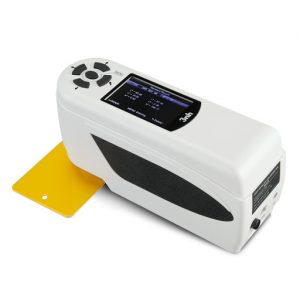
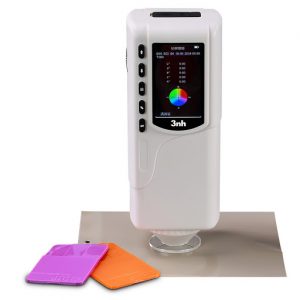
To harness its expertise and cater to different markets, 3nh offers different models of colour meters with each one having certain specific features necessary for that application. The following are the different types of colour meters from 3nh Technology:
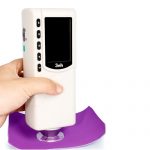
| Entry Level Model Without PC Software | |
| Illuminating/Viewing Geometry | 8/d |
| Measuring Aperture | Φ8mm flat aperture; Φ4mm tip aperture |
| Color Space | CIE LAB |
| Color Difference Formula | ΔE*ab |
| Repeatability | Standard deviation within ΔE*ab 0.03 (Average of 30 measurements of standard white plate) |
| Errors Between Each Equipment | Within ΔE*ab 4 (Average for 12 BCRA Series II color tiles) |
| Data Memory | 100pcs standards 10000pcs samples |
| PC Software | No |
| Samples | Can measure solid and powder samples with accessory |
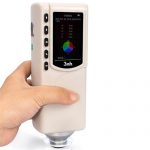
| Entry Level Model with PC Software | |
| Illuminating/Viewing Geometry | 8/d |
| Measuring Aperture | Φ4mm tip and Φ4mm flat aperture |
| Color Space | CIEL*a*b*C*h* CIEL*a*b* CIEXYZ |
| Color Difference Formula | △E*ab △L*a*b* △E*C*h* |
| Errors Between Each Equipment | ≤0.80ΔE*ab |
| Storage | 100pcs standards 20000pcs samples |
| Repeatability | Standard deviation within ΔE*ab 0.08 Average of 30 measurements of standard white plate |
| PC Software | Yes, Free Software (CQCS3 Software) |
| Samples | Can measure solid and powder samples with accessory |
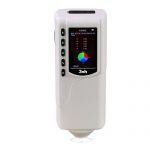
Entry Level Model with 45/0 Geometry | |
Illuminating/Viewing Geometry | 45°/0° |
Measuring Aperture | Φ8mm |
Color Space | CIEL*a*b*C*h* CIEL*a*b* CIEXYZ |
Color Difference Formula | △E*ab △L*a*b* △E*C*h* |
Errors Between Each Equipment | ≤0.80ΔE*ab |
Storage | 100pcs standards 20000pcs samples |
Repeatability | Standard deviation within ΔE*ab 0.08 Average of 30 measurements of standard white plate |
PC Software | Yes, Free Software (CQCS3 Software) |
Samples | Can measure solid and powder samples with accessory |
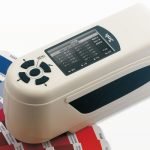
| Advanced Model | |
| Illuminating/Viewing Geometry | 8/d |
| Measuring Aperture | One Aperture – Φ8mm |
| Color Space | CIEL*a*b*C*h* CIEL*a*b* |
| Color Difference Formula | △E*ab △L*a*b △E*C*h |
| Errors Between Each Equipment | ≤0.50ΔE*ab |
| Storage | 100pcs standards 20000pcs samples |
| Repeatability | Standard deviation within ΔE*ab 0.08 Average of 30 measurements of standard white plate |
| PC Software | Yes, Free Software (CQCS3 Software) |
| Samples | Can measure solid, powder & even liquid samples with accessory |
Colour meters vary based on a few factors which change the applications for which each model can be used. The following are the varying factors in different colour meter models.
The perception of the colour of an object varies based on the light in which it is viewed. Hence, it is necessary to have standard illuminants to get a standardized colour value. The Commission International de l’Eclariage (CIE) has standardized light sources based on the amount of emitted energy at each wavelength.
The commonly used light sources for colour measurement are:
The observer is the human eye viewing the object. It continuously analyses all sorts of colour around it and sends the data to the brain. According to the three-component theory, our eyescan only sense the three primary colors of light—red, green, and blue. Every other colour in the visible spectrum is a unique mixture of these three colours.
To determine the sensitivity of eye receptors, CIE has done several tests. Based on the results of these studies, two viewing angles have been standardized—2° and 10°. These angles represent both small and large fields of view.
Over the years, there have been several attempts to objectively define and express colour. This was to ensure easy and accurate exchange of colour information. Just like how length is expressed in numbers, various methods were proposed to express colour numerically.
Two of the most popular colour systems are Yxy and L*a*b. The former was developed based on the tri-stimulus theory of colour perception while the latter was developed to give a more balanced colour difference, which is relative to parallax. In the modern day, both are widely applied in color communication.
The CIE LAB is one the most used colour systems worldwide. It was developed by the International Commission on Illumination (ICI). The CIE LAB colour space defines colour in 3 axes mutually perpendicular to each other i.e. L, A, and B axes.
L defines colour in lightness, having values from pure white to pitch black
A defines colour in red-green scale
B defines colour in blue-yellow scale
For a sample measured, the colour meter will provide colour values in each axis (L, A, B).
Apart from the LAB colour scale, other popular colour scales include LCH scale, Hunter LAB scale, and a few others.
ΔE is used to measure the difference in colour between two surfaces. This parameter is usually employed in quality control to ensure consistency by comparing the produce with the master sample. Colour difference is defined by the following formula:
![]()
Since measuring the colour of various surfaces is important in numerous different fields, 3nh colorimeters are found useful in numerous industries including:
The colour of grains, flour, fruits, and vegetables is used as a parameter to assess the quality of the product. With research on agriculture and food industry gaining ground with every passing day, colour measurement has become an integral part of the food and beverages sector.
There are more than ten million colours that the human eye can perceive. Aesthetic appearance and packaging of products play a major role in determining the sales of products. Hence, colour meters are used to objectively measure the colour of packaging material and analyse how they are perceived by consumers.
Paint is a commonly used material to enhance the look of objects. It plays a major role in buildings, automobile, plastics, and so on. Hence, international manufacturers aim to standardize the colour of their products. Colour meters are useful instruments to have for such applications.
Other than the above-mentioned industries, colour meters are also widely used in textile, automobile, plastic, chemical, and pharma companies.
Agaram Industries is the authorized distributor of 3nh colorimeters in India. To get a quotation with the colour meter price, you can fill up this form or directly send an email to sales@agaramindia.com.
INTERESTED IN OUR PRODUCTS?
Related Products